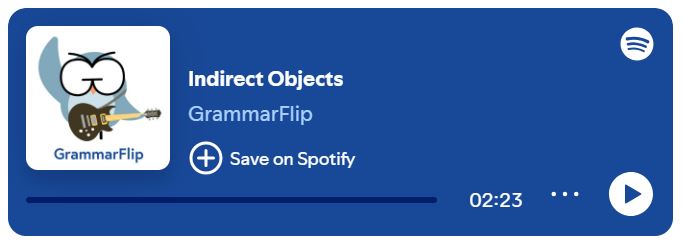What is an Indirect Object?
An indirect object is a noun or pronoun that names the recipient of the direct object and always appears after the verb but before the direct object.
Some examples of indirect objects would be the following:
The teacher handed the students the graded tests. (“handed” = transitive verb; “tests” = direct object; “students” = indirect object)
Audrey passed Bridget the soccer ball. (“passed” = transitive verb; “ball” = direct object; “Bridget” = indirect object)
Kiana bought her dog peanut butter treats. (“bought” = transitive verb; “treats” = direct object; “dog” = indirect object)
My parents gave me a new backpack before school started. (“gave” = transitive verb; “backpack” = direct object; “me” = indirect object)
Long-Form Videos: Indirect Objects
Long-form instructional video lessons allow students to engage with grammar concepts in more depth and detail.
This format provides students with a stronger foundation and a more comprehensive understanding of indirect objects.
Grammar-in-Context Videos: Indirect Objects
GrammarFlip’s grammar-in-context videos provide an additional layer of instruction, learning, and relatability.
Our unique and memorable video footage helps solidify the understanding of challenging grammar concepts.
Watch this video to better understand indirect objects!
Short-Form Videos: Indirect Objects
Short-form videos are an excellent way to review grammar concepts. Our two-minute instructional videos help students review the concept of indirect objects to further solidify their understanding.
Memorable Images: Indirect Objects
The use of images to connect visual cues with concepts makes it simpler for students to grasp and remember key ideas. GrammarFlip’s memorable images create visual associations that make indirect objects more engaging and easier to retain.

Definition Cards: Indirect Objects

Definition cards reinforce grammar concepts by providing clear and concise explanations that students can easily reference for quick review and better retention. GrammarFlip’s definintion cards help students review the concept of indirect objects to further solidify their understanding.
Music: Indirect Objects
Learn grammar concepts through music! The unique verses and catchy chorus in our “Indirect Objects Song” will help your students further understand indirect objects. Listen for yourself and see if you don’t walk away singing this song to yourself!
Listen to GrammarFlip Music via Spotify, Apple, or Amazon!
Music Videos: Indirect Objects
Music videos make grammar concepts more engaging and memorable by combining rhythm, visuals, and repetition to reinforce learning. GrammarFlip’s music videos help students retain the concept of indirect objects more effectively while making the learning process fun and interactive.
What to Know About Indirect Objects
There are a few things that you will want to know about indirect objects:
1. In order for there to be an indirect object in the sentence, there must be a direct object. In other words, you can’t have an indirect object without a direct object.
2. Indirect objects always appear between the verb and direct object in a sentence. These parts of the sentence will appear in the following order:
Verb | Indirect Object | Direct Object
I passed Gabriella the ball. (passed = verb, Gabriella = indirect object, ball = direct object)
3. Indirect objects can never be inside of a prepositional phrase. Never.
4. Many times, indirect objects can be rephrased and placed into a prepositional phrase:
Hadley gave Antonio a gift.
Hadley gave a gift to Antonio.
Notice that in the first sentence “Antonio” is the indirect object, but in the second sentence we simply rephrased it, and “Antonio” is no longer the indirect object; instead, “Antonio” is now the object of the preposition.
Download a Free Worksheet on Indirect Objects!
Click the image below to download your free worksheet on indirect objects!

Do your students understand the difference between direct and indirect objects?
Explore More GrammarFlip Lessons!
Parts of Speech lessons provide the building blocks of grammar. GrammarFlip covers these topics in detail to ensure a solid foundation is built. First time learners and students seeking to review the parts of speech can both benefit from the instructional videos and slide show reviews.
Parts of the Sentence lessons are critical for understanding how the parts of speech function in language construction. From the basic to the advanced, these lessons will cover a wide range of grammar topics that can be used in any grade level or classroom.
Mechanics and Usage lessons equip students with the necessary skills to communicate clearly to all audiences. With a focus on the application of these concepts in student writing, these lessons tie together both simple constructions of grammar as well as the more complex such that any age or skill level of student will benefit.



